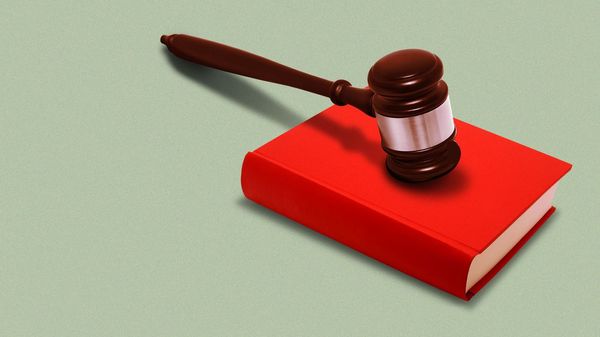On Monday, the Supreme Court granted a stay in Noem v. Perdomo. The vote was (likely) 6-3. Justice Kavanaugh wrote a ten-page concurrence. Justice Sotomayor, joined by Justices Kagan and Jackson, wrote a twenty-page dissent.
This case was first filed on August 7, and briefing was completed on August 13. The Justices in the majority had about a month to put together a majority opinion. They didn't. Why? Perhaps the majority could not come to a consensus on a single line of reasoning--whether on Article III standing or the Fourth Amendment. Perhaps the majority simply didn't feel the need to write a majority opinion, because this is only an interim order. Or maybe a book tour got in the way of writing something. Well, it's hard to read the opinion when there isn't an opinion to read.
I don't have any particular expertise on the interaction between Article III standing and police stops, or on the Fourth Amendment issue. But I will commend Justice Kavanaugh, once again, for explaining his thinking. I don't know if Kavanaugh's views command a majority of the Court, but it is difficult to think of any other basis on which a stay could have been granted. We've seen some lower courts favorably cite dissents on the emergency docket. I think the judges in California would be prudent to cite Justice Kavanaugh's concurrence over Justice Sotomayor's dissent.
Justice Kavanaugh writes that the two "most critical" factors when deciding to grant a stay are certworthiness and irreparable arm
To obtain a stay from this Court, the moving party must demonstrate a fair prospect that, if the District Court's decision were affirmed on appeal, this Court would grant certiorari and reverse. The moving party also must show a likelihood that it would suffer irreparable harm if a stay were not granted. Those two factors are the "most critical." Nken v. Holder, 556 U. S. 418, 434 (2009).
I didn't remember Nken calling those two factors the "most critical." And it didn't. Rather, Nken found that the two "most critical" actors were likelihood of success on the merits and irreparable harm. Cert-worthiness was not discussed at all in Nken. But this factor was discussed in Hollingsworth v. Perry, which Justice Barrett amplified in Does v. Mills. Justice Kavanaugh is tweaking the standard here. He very well might be right about what are the two most factors in his view, but I don't think that comes from Nken.
I continue to think cert-worthiness is not a useful factor. Each Justice has a different threshold for whether a case is cert-worthy. Justice Kavanaugh, to his credit, signals that he wants to grant more cases. Same for Justices Thomas, Alito, and Gorsuch. Justice Barrett is the most stingy justice with cert-grants. We should not pretend cert-worthiness adds much to the equation, beyond a Justice's subjective valuation of how important a case is.
Because Justice Kavanaugh thinks that the case is cert-worthy, and the government will suffer irreparable harm in the absence of a stay, he turns to balancing the harms and equities. But Justice Kavanaugh immediately pivots, and explains that balancing the harms and equities is really tough in a case like this:
Turning then to the balance of harms and equities: Aswith many other applications for interim relief to this Court, the harms and equities may appear weighty on both sides. . . . Moreover, in a case like this involving government action, balancing the harms and equities can become especially difficult and policy-laden.
Why is this task so tough? Because of the "harms to the third parties who otherwise would benefit from the challenged government action." Justice Kavanaugh does not spell out this point clearly. But if I am reading between the lines, the third parties would be Americans who benefit from the deportation of illegal aliens. I'll return to Justice Kavanaugh's discussion of illegal immigration below.
Footnote 3 revisits Justice Kavanaugh's concurrence in NetChoice v. Fitch. That opinion left me a bit confused about how to conceptualize the relationship between balancing the equities and likelihood of success on the merits. Footnote 3 offers a way to reconcile those prongs.
In Fitch, Kavanaugh explains, there was a state law, and enjoining it for the interim status would not have caused much harm to the porn companies. But when there is a "significant new law," there are harms on both sides of the ledger.
There can be situations where, based on the record before this Court, it appears that a temporary injunction or stay would not impose much if any harm on the non-prevailing party in the interim period before a final judgment. See, e.g., NetChoice, LLC v. Fitch, 606 U. S. ___, ___ (2025) (KAVANAUGH, J., concurring in denial of application to vacate stay) (slipop., at 2); Response in Opposition in NetChoice, LLC v. Fitch, No. 25A97, pp. 38–39. But especially in cases involving a significant new law or government action, the interim harms and equities are typically weighty on both sides.
Justice Kavanaugh then turns to Labrador v. Poe. In candor, the state law at issue in Labrador and the state law at issue in Fitch both seem "significant" and "new." I'm not sure why the likelihood of success on the merits was not enough to deny the stay in Fitch. But in any event, Kavanaugh explains that the court should turn to the likelihood prong for these sorts of "significant" laws.
In those situations, as I have explained before, resolving the application therefore often will depend on this Court's assessment of likelihood of success on the merits. See Labrador v. Poe, 601 U. S. ___, ___–___ (2024) (KAVANAUGH, J., concurring in grant of stay) (slip op., at 3–4) (when applicant has demonstrated irreparable harm and when the harms and equities are weighty on both sides, "this Court has little choice but to decide the emergency application by assessing likelihood of success on the merits"); Trump v. CASA, Inc., 606 U. S. ___, ___ (2025) (KAVANAUGH, J., concurring) (slip op., at 10) ("[I]n deciding applications for interim relief involving major new statutes or executive actions, we often have no choice but to make a preliminary assessment of likelihood of success on the merits; after all, in cases of that sort, the other relevant factors (irreparable harm and the equities) are often very weighty on both sides").
I think the order of operations can be stated plainly. The most important two factors at the outset are whether the case is cert-worthy and whether the moving party would suffer irreparable harm in the absence of a stay. Next, the Court will balance the harms and equities. But if that balancing test is difficult, especially in a "significant" case, the court should consider which side is likely to prevail on the merits. Does that sound right?
Finally, I have to point out the nomenclature.
In June 2020, Justice Kavanaugh made headlines by using the term "noncitizen" instead of alien. He wrote in Barton v. Barr:
This opinion uses the term "noncitizen" as equivalent to the statutoryterm "alien." See 8 U. S. C. §1101(a)(3).
As best as I can tell, Justice Kavanaugh has continuously used the neologism "noncitizen," even as Justices Thomas and Alito continue to use the correct statutory term, "alien." Or at least Justice Kavanaugh did so before Noem v. Perdomo.
Justice Kavanaugh repeatedly refers to illegal immigrants and illegal immigration. The word "noncitizen" is used only once in passing. Consider this passage:
The Government estimates that at least 15 million peopleare in the United States illegally. Many millions illegally entered (or illegally overstayed) just in the last few years. Illegal immigration is especially pronounced in the LosAngeles area, among other locales in the United States. About 10 percent of the people in the Los Angeles region are illegally in the United States—meaning about 2 million illegal immigrants out of a total population of 20 million.
Indeed, Justice Kavanaugh goes further and acknowledges problems caused by illegal immigration:
So it is in this case, particularly given the millions of individuals illegally in the United States, the myriad"significant economic and social problems" caused by illegal immigration, Brignoni-Ponce, 422 U. S., at 878, and the Government's efforts to prioritize stricter enforcement of the immigration laws enacted by Congress.
And as noted above, Kavanaugh alludes to harms to third parties when illegal aliens are not deported:
That is because a court must balance the harms to the regulated and negatively affected parties not only against the harms to the Government as an institution, but also against the harms to the third parties who otherwise would benefit from the challenged government action.
Is Justice Kavanaugh alluding to illegal aliens who may commit crimes if not deported?
Justice Kavanaugh does acknowledge the reasons why people illegally migrate to the United States. He also recognizes that different administrations have different enforcement priorities--leading to some whiplash.
To be sure, I recognize and fully appreciate that many (not all, but many) illegal immigrants come to the UnitedStates to escape poverty and the lack of freedom and opportunities in their home countries, and to make better lives for themselves and their families. And I understand that they may feel somewhat misled by the varying U. S.approaches to immigration enforcement over the last few decades. But the fact remains that, under the laws passed by Congress and the President, they are acting illegally by remaining in the United States—at least unless Congress and the President choose some other legislative approach to legalize some or all of those individuals now illegally present in the country. And by illegally immigrating into and remaining in the country, they are not only violating the immigration laws, but also jumping in front of those noncitizens who follow the rules and wait in line to immigrate into the United States through the legal immigration process.
But ultimately, none of this matters, as illegal aliens "jumped" in front of the line. (Reminds me of my experience while waiting for the DACA oral argument.)
I think we are seeing based Brett--and I like it.
The post Justice Kavanaugh Continues To Be The Only Justice To Explain Emergency Docket Orders appeared first on Reason.com.







